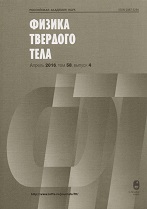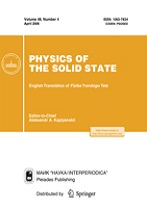|
This article is cited in 10 scientific papers (total in 10 papers)
Polymers
Mechanism of formation of carbon–vacancy structures in silicon carbide during its growth by atomic substitution
S. A. Kukushkinabc, A. V. Osipovb
a Institute of Problems of Mechanical Engineering, Russian Academy of Sciences, St. Petersburg
b St. Petersburg National Research University of Information Technologies, Mechanics and Optics
c Peter the Great St. Petersburg Polytechnic University
Abstract:
The mechanism of formation of carbon-vacancy structures in silicon carbide SiC from silicon vacancies that inevitably form during synthesizing SiC from Si by atomic substitution has been studied. It is shown that it is useful for one of four nearest carbon C atoms to be displaced to the place of a silicon vacancy with the decrease in the total energy by 1.5 eV in the case of polytype 3C and by 0.9–1.4 eV in the case of polytype 4H. In this case, the C atom must overcome the activation barrier of 3.1 eV in the case of polytype 3C and by 2.9–3.2 eV in the case of polytype 4H. This transition is realized during synthesizing SiC due to thermal fluctuations, since the synthesis temperature is T $\approx$ 1200–1300$^{\circ}$C. Thus, the carbon–vacancy structure is a nearly flat cluster of four C atoms and related carbon vacancy with a characteristic diameter of $\sim$4 $\mathring{\mathrm{A}}$ at a distance of 2.4 $\mathring{\mathrm{A}}$ from it. All the characteristics of this transformation, namely, the energy profile, the transformation pathway, the transient state, its frequency spectrum, the eigenvector corresponding to the only negative eigenfrequency are calculated by the elastic band method. The infrared spectrum (IR) and the permittivity of SiC containing carbon–vacancy structures are considered. The new line at 960 cm$^{-1}$ detected recently in the IR spectrum of grown by the atomic substitution is unambiguously identified with vibrations of C atoms in carbon–vacancy structures. It is concluded that carbon–vacancy structures stabilize cubic polytype SiC–3C.
Received: 19.03.2018
Citation:
S. A. Kukushkin, A. V. Osipov, “Mechanism of formation of carbon–vacancy structures in silicon carbide during its growth by atomic substitution”, Fizika Tverdogo Tela, 60:9 (2018), 1841–1846; Phys. Solid State, 60:9 (2018), 1891–1896
Linking options:
https://www.mathnet.ru/eng/ftt9094 https://www.mathnet.ru/eng/ftt/v60/i9/p1841
|


| Statistics & downloads: |
| Abstract page: | 46 | | Full-text PDF : | 5 |
|





 Contact us:
Contact us: Terms of Use
Terms of Use
 Registration to the website
Registration to the website Logotypes
Logotypes








 Citation in format
Citation in format 
